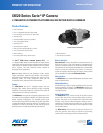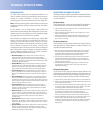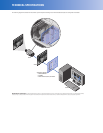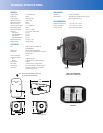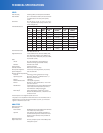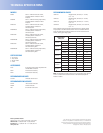
TECHNICAL SPECIFICATIONS
PELCO ANALYTICS
The IXE20 series includes eight user-configurable behaviors. The
camera is capable of running up to three behaviors at the same time;
although, the number of behaviors is limited to the available
processing power of the camera and the type of analytic being used.
Note:
Available processing power is determined by the settings for
compression standards, resolution, image rate, bit rate, and analytic
configuration.
For each behavior, you can create several custom profiles that
contain different camera settings. With these profiles, you can set up
different scenarios for the behavior, which will automatically detect
and trigger alarms when specific activity is detected.
Pelco Analytics are configured and enabled using a standard Web
browser, and Pelco behaviors are compatible with Endura or a
third-party system that supports Pelco’s Analytics API system.
Multiple Pelco behaviors can be scheduled to work during a certain
time or condition. For example, during the day, a camera can be
configured with Object Counting to count the number of people that
enter a lobby door. At night, the operator can change the profile to
Camera Sabotage to trigger an alarm if a camera is moved or
obstructed. Available Pelco behaviors include:
•
Abandoned Object:
Detects objects placed in a defined zone and
triggers an alarm if the object remains in the zone longer than the
user-defined time allows. An airport terminal is a typical installation for
this behavior. This behavior can also detect objects left behind at an ATM,
signaling possible card skimming.
•
Adaptive Motion:
Detects and tracks objects that enter a scene and
then triggers an alarm when the objects enter a user-defined zone. This
behavior is primarily used in outdoor environments with light traffic to
reduce the number of false alarms caused by environmental changes.
•
Camera Sabotage:
Detects contrast changes in the field of view. An
alarm is triggered if the lens is obstructed with spray paint, a cloth, or a
lens cap. Any unauthorized repositioning of the camera also triggers an
alarm.
•
Directional Motion:
Generates an alarm in a high traffic area when a
person or object moves in a specified direction. Typical installations for
this behavior include an airport gate or tunnel where cameras can detect
objects moving in the opposite direction of the normal flow of traffic or an
individual entering through an exit door.
•
Loitering Detection:
Identifies when people or vehicles remain in a
defined zone longer than the user-defined time allows. This behavior is
effective in real-time notification of suspicious behavior around ATMs,
stairwells, and school grounds.
•
Object Counting:
Counts the number of objects that enter a defined zone
or cross a tripwire. This behavior might be used to count the number of
people at a store entrance/exit or inside a store where the traffic is light.
This behavior is based on tracking and does not count people in a
crowded setting.
•
Object Removal:
Triggers an alarm if an object is removed from a
defined zone. This behavior is ideal for customers who want to detect the
removal of high value objects, such as a painting from a wall or a statue
from a pedestal.
•
Stopped Vehicle:
Detects vehicles stopped near a sensitive area longer
than the user-defined time allows. This behavior is ideal for airport
curbside drop-offs, parking enforcement, suspicious parking, traffic lane
breakdowns, and vehicles waiting at gates.
OBJECTVIDEO (OV) ANALYTIC SUITES
ObjectVideo Analytics Suites are preloaded on selected IXE20 Series
cameras and require an OV Ready system to configure the behaviors
for alarm notification.
OV Security Suite
The OV Security Suite is easy to use and includes Tripwire Detection,
Inside Area Detection, and Camera Tamper Detection behaviors.
• Tripwire Detection identifies objects that cross a user-defined line drawn
within the camera’s field of view.
• Inside Area Detection identifies objects entering, appearing, or moving
within a user-defined area.
• Camera Tamper Detection identifies significant contrast changes in the
camera’s field of view; for example, if the lens is obstructed by spray
paint, a cloth, or a lens cap.
OV Security Suite Plus
The OV Security Suite Plus includes the behaviors of the OV Security
Suite plus Multi-Line Tripwire Detection, Loitering Detection, and
Leave Behind Detection behaviors.
• Multi-Line Tripwire Detection identifies objects that cross two defined
lines and generates an event based on defined parameters, including
directionality. Defined parameters for this behavior include direction,
sequential order, and time between crossing each tripwire.
• Loitering Detection identifies when people or vehicles remain within a
user-defined area beyond a specified period of time. This behavior is
effective for real-time notification of suspicious behavior around ATMs,
stairwells, and school grounds.
• Leave Behind Detection detects objects placed in a defined zone and
triggers an alarm if the object remains in the zone longer than the
user-defined time allows.
OV Event Counting Suite
The OV Event Counting Suite uses advanced object calibration and
additional features for schedules, parameters, and multiple rules. The
suite includes behaviors for Tripwire Counting, Enters/Exits Counting,
Loiter Counting, Occupancy Sensing, and Dwell-Time Monitoring.
• Tripwire Counting counts people or objects that cross a user-defined line.
• Enters/Exits Counting calculates the number of people that enter and exit
an area without using a tripwire.
• Loiter Counting is useful in analyzing how frequently people stop in front
of a product, display, or other area of interest. This feature is also useful
in assessing promotion effectiveness and product interest.
• Occupancy Sensing counts people and generates a new value every time
the occupancy level changes. Since each occupancy output is
time-stamped, the data can be used to determine average occupancy
levels or to correlate data to point-of-sale or other business scenarios.
• Dwell-Time Monitoring rules can be set up to record the length of time it
takes an object to enter and exit an area. Along with queue size
information, wait times can also be assessed. This behavior can be used
to evaluate consumer interaction for a point-of-sale display or digital
advertisement.



